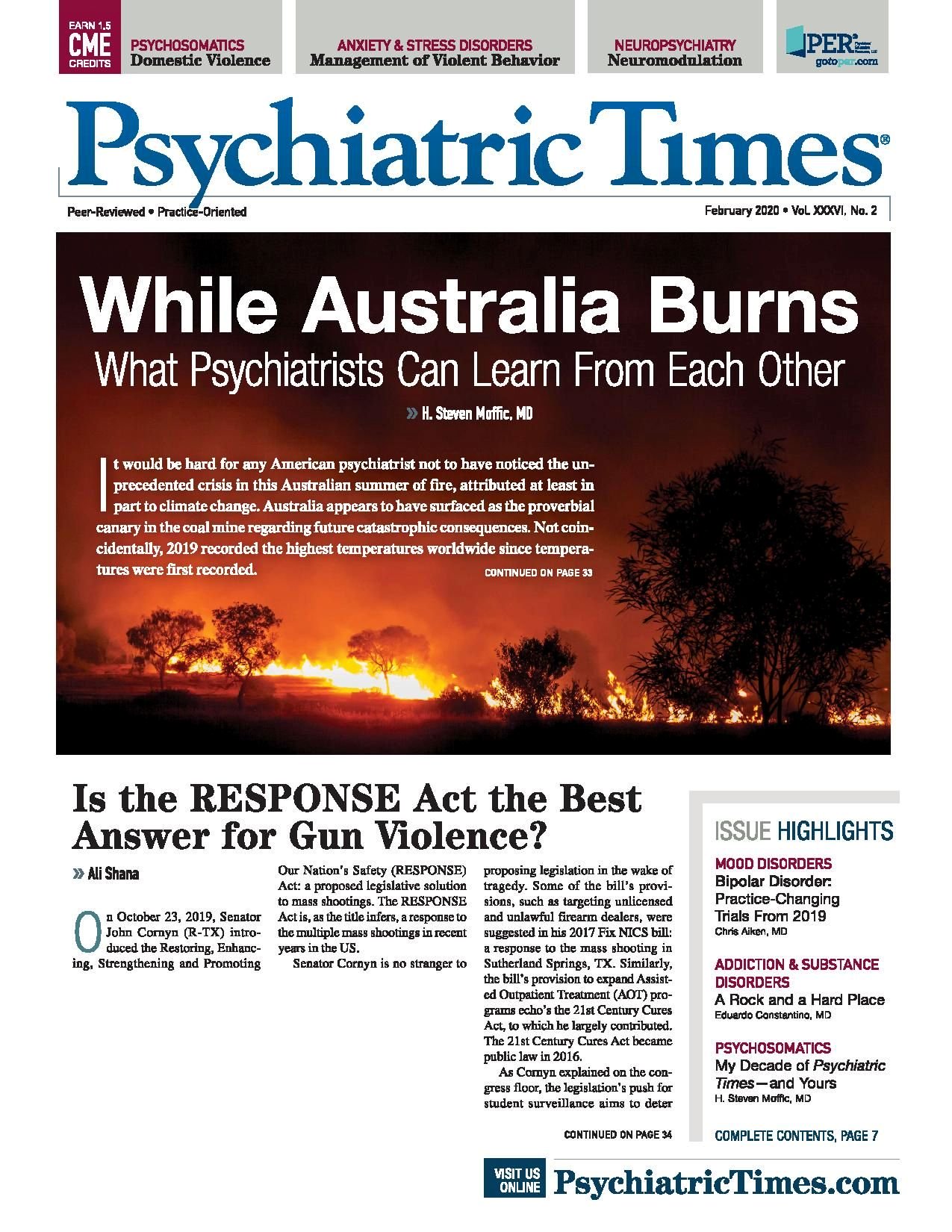Publication
Article
Psychiatric Times
Is the RESPONSE Act the Best Answer for Gun Violence?
Author(s):
On October 23, 2019, Senator John Cornyn (R-TX) introduced the Restoring, Enhancing, Strengthening and Promoting Our Nation’s Safety (RESPONSE) Act: a proposed legislative solution to mass shootings.

On October 23, 2019, Senator John Cornyn (R-TX) introduced the Restoring, Enhancing, Strengthening and Promoting Our Nation’s Safety (RESPONSE) Act: a proposed legislative solution to mass shootings. The RESPONSE Act is, as the title infers, a response to the multiple mass shootings in recent years in the US.
Senator Cornyn is no stranger to proposing legislation in the wake of tragedy. Some of the bill’s provisions, such as targeting unlicensed and unlawful firearm dealers, were suggested in his 2017 Fix NICS bill: a response to the mass shooting in Sutherland Springs, TX. Similarly, the bill’s provision to expand Assisted Outpatient Treatment (AOT) programs echo’s the 21st Century Cures Act, to which he largely contributed. The 21st Century Cures Act became public law in 2016.
As Cornyn explained on the congress floor, the legislation’s push for student surveillance aims to deter acts of violence, hate crimes, and domestic terrorism. Components of the RESPONSE Act include:
• Expanding mental health crisis teams;
• Improving coordination between mental health providers and law enforcement;
• Granting law enforcement “access to information about potential threats-particularly those made online;”
An expected mix of advocacy group reactions
The proposed legislation sparked intense reactions from numerous advocacy groups in the realms of health care, civil rights, law enforcement, and privacy. In fact, more than 20 different organizations have mobilized as the Coalition for Smart Safety to voice their concerns regarding the RESPONSE Act. This coalition includes the Bazelon Center for Mental Health Law, the National Disability Rights Network, the American Association of People with Disabilities, the Disability Rights Education and Defense Fund, and the National Association for Rural Mental Health.
However, not all mental health organizations view the bill negatively. Major advocates of the bill include the National Council for Behavioral Health, the National Alliance on Mental Illness, and the Treatment Advocacy Center.
Same reasoning, different conclusions
The coalition’s concern, outlined in their letter to the Senator, takes issue with gun violence legislation that targets the mentally ill.
While we applaud the recognition that the federal government has a role to play in addressing the grave and complex issues surrounding mass violence, the undersigned oppose legislation that links efforts to reduce mass violence with mental health reforms. There is a need to expand and improve community mental health services, but legislation to address those issues should be separated from legislation to address gun violence; the two are not connected. The evidence has clearly and consistently shown that mental health disabilities are not predictors of gun violence.1 We are concerned that, by focusing on mental health reforms, the RESPONSE Act will do little to limit future instances of mass violence, and will instead fuel prejudice, fear, and marginalization of individuals with mental health disabilities. It may also lead many people to avoid seeking needed services.
The letter goes on to read:
Studies have repeatedly shown that people with disabilities, including mental health disabilities, are far more likely to be victims of gun violence than perpetrators.2 In fact, recent studies demonstrate that only 4% of gun violence is committed by people with mental health disabilities.1
The National Council for Behavioral Health recognizes that people with mental illness are rarely violent perpetrators. According to Dr Joe Parks, Medical Director of the National Council, “People who perpetrate mass violence have a rate of mental illness that’s only slightly greater than the general population, and it’s unclear there is a causal effect.” Parks is more aware of this than most people. He recently spearheaded the National Council’s Medical Directors Institute report Mass Violence in America. The report included a wide panel of experts ranging from psychiatry, psychology, law enforcement, related researchers, and select court judges. “We do, of course, always think it’s good to increase access to treatment for mental illness crisis services,” Parks continued.
One reason some mental health organizations protest the bill while others support it is AOT’s potential role in preventing gun violence. The coalition’s letter makes their stance very clear: “Repeated studies have shown no evidence that mandating outpatient treatment through court is effective,” they wrote. Nonetheless, the National Council’s support for the bill doesn’t center around AOT expansion. “I don’t really have a strong opinion one way or the other about the availability of [AOT],” says Parks.
Reyna Taylor, Vice President of Public Policy for the National Council, says their support for the RESPONSE Act centers around the Crisis Stabilization and Community Reentrance program. “In that section of the act, they actually specify the need to connect people to community- based mental health clinics,” says Taylor. “So instead of talking once a person has reached the point of crisis, we need to talk about how to get people care so they don’t enter crisis.”
Indeed, the National Council does not believe AOT’s availability is the issue when there is a lack of service networks to order individuals into. “Which is why our major recommendation is expansion and extension of Certified Community Behavioral Health Centers (CCBHCs),” says Parks. According to Parks, CCBHCs have increased access by 25% in areas where they have been implemented. They operate 24/7, cover a full range of treatment services (eg, mental health, substance abuse), and are required to take everybody regardless of their insurance-or lack thereof.
Surprisingly, opponents of the bill also emphasized a need for community-based treatment, writing that “alternative community-based mental health treatment” would serve the mentally ill better than current AOT programs.
The difference in support lies in the potential role of AOT. While the National Council supports the bill, they do so because it calls for community-based treatment, which Parks says is a crucial step if AOT is to be implemented: “There’s no point in increasing the mechanisms [of AOT] when what you’re ordering them into isn’t promptly available . . . In fact, many of them probably wouldn’t need to be ordered if the [patient] could have gotten prompt access to treatment initially.”
The bill’s push for a CCBHC model may also change the way psychiatrists get paid. “Seventy percent of our members . . . reported losing money on psychiatry because the rates were too low,” says Parks. “Well, certified community behavioral health centers fix that because their rates are set based on their individual agency costs of providing care.” This prevents payment rates for psychiatrists from being lower than the actual cost of providing care. CCBHCs are able to offer salaries that are competitive with local insurance plans and the cash market. “Which for psychiatrists, 40% are in the cash market. You have to offer competitive rates to get access.”
Something to consider
To be sure, the coalition’s letter addresses several concerns outside of the legislation’s mental health component-disagreements with student surveillance, suggested protocol for educators to report suspicious behavior, and the like. Such reasons are why civil rights-focused organizations including the National Council on Independent Living and the Connecticut Legal Rights Project have joined the coalition.
But the bill’s mental health component-Part 00: Crisis Stabilization and Community Reentry Program starting at Sec. 3101-shares some health care reform goals mentioned in the letter of concern. Supporters and opponents alike advocate for community-based treatment. The disagreement is how community-based health care reform should come about. The coalition believes mental health reform should be separate from gun violence legislation.
As of now, the bill has not passed the Senate. Likewise, the Protecting Communities and Preserving the Second Amendment bill introduced on May 16 by Senator Chuck Grassley (R-IA) and Senator Ted Cruz (R-TX) has not passed. This gun violence bill also focuses on targeting mentally ill individuals. However, the Helping Families in Mental Health Crisis Act of 2016, an updated version of the same bill introduced in 2013 following the Sandy Hook shooting, was passed. This bill includes numerous similarities to the RESPONSE Act’s mental health component, including increased access to mental health treatment, funding, and expansion of AOT programs.
Disclosures:
Ali Shana is a freelance writer. He is currently studying clinical mental health counseling at the University of Milwaukee, WI. He reports on rehabilitation, drug policy reform, and health care issues.
References:
1. Metzl JM, MacLeish KT. Mental illness, mass shootings, and the politics of American firearms. Am J Pub Health. 2015;105:240-249.
2. Kim S. The Dangers of the Mental Health Narrative When it Comes to Gun Violence. Forbes. Aug. 7, 2019.







